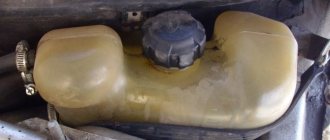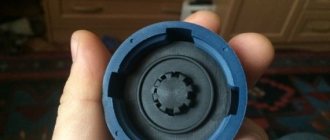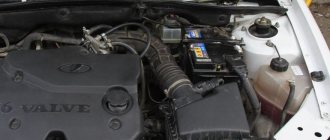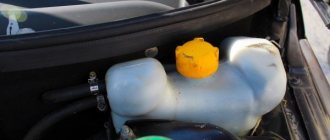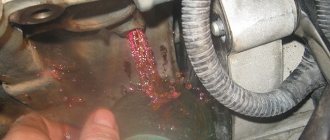The attention of drivers who are accustomed to servicing their car themselves is usually focused on the engine and chassis. Of course, these components are considered basic in the operation of the entire car. However, equal attention must be paid even to such seemingly insignificant details as the cap on the expansion tank. What role does this element play in the cooling system? Most drivers don’t even realize that the quality of engine cooling depends entirely on this cover!
What is the main role of the tank cap?
As is known, a running engine creates a pressure in the cooling system that differs from normal atmospheric pressure. This occurs due to the fact that the coolant heats up along with the engine, as a result of which it expands and increases in volume. As a result, the pressure inside the engine cooling system (ECS) increases, but it is not in contact with the external environment, and there is nowhere for it to relieve excess pressure.
Developers of modern cars do not fight the increased pressure in the ODS “radically” - they do not try to completely get rid of it. It is adjusted using the tank cap. Increased pressure in the SOD is used to shift the coolant boiling point. After all, it’s no secret that at normal atmospheric pressure for water it occurs at a temperature of 100 °C, for antifreeze – 105–110 °C, and for antifreeze – 120 °C. The operating temperature of modern car engines is very close to these critical values.
So, for example, for carburetor VAZs it should be in the range of 90–95 °C, and for injection ones – 97–105 °C.
However, under certain engine operating conditions, a short-term increase in its temperature occurs to higher values, which, however, does not lead to failure of a serviceable engine, but causes the same heating of the coolant. For example, on injection VAZ 2109 the liquid at such moments can be 120–125 °C. Obviously, even antifreeze cannot withstand such heat. At the same time, an increase in the pressure of any liquid leads to an increase in its boiling point.
Injection VAZ 2109
Engineers designing engines have long found out that to prevent the coolant from boiling even during short-term critical heating of the engine, it is enough to maintain the pressure in the coolant at the level of 1.1–1.5 kgf/cm 2 (1.1–1.5 bar). A higher temperature is not needed, because the engine is not designed for it, and it will lead to its failure. And it makes no sense to allow a greater spontaneous increase in pressure, which can nevertheless occur, because it will complicate the process of manufacturing and servicing the motor, as well as increase its cost, since it will require a more durable and sealed SOD (more durable pipes and expansion tank, strong clamps).
Therefore, the tank lid must be sealed, but only up to the required pressure limits indicated above, after reaching which it maintains them, connecting the system with the external environment as necessary to release the air compressed inside the expansion tank.
How to flush the cooling system on a Lada Grant
Violation of the deadlines for replacing the fluid, the purchase of cheap analogues contributes to the formation of sediment in the line and clouding of the antifreeze.
Due to the loss of chemical and physical properties, the water jacket of the power unit is subject to corrosion and peeling.
A constantly elevated operating temperature is the first sign of contamination, deposit formation, or thermostat malfunction. The manufacturer recommends cleaning the lines every 50,000 km. Replacement of antifreeze after 75,000 km.
The volume of the Lada Granta cooling system is 8.0 liters.
Cleaning methods
- external;
- internal.
In the first case, all dirt is removed from the outside using water pressure and adding detergent. In the second case, washing is carried out inside with special chemicals.
If the flushing does not give a positive result, then we replace the standard radiator with a new one, since an excess amount of fossils has accumulated at the bottom and the corrosion process has begun.
Distilled water
We use distilled water
You can get distilled water in several ways:
- buy at a pharmacy;
- melt clean snow;
- let tap water stand for six months.
The washing process is as follows:
- We place the car on the inspection channel, unscrew the fastenings of the oil pan protection.
- We twist the drain plug of the system and grind off the antifreeze. First, unscrew the cap from the expansion tank and relieve pressure.
- After the waste has been drained, tighten the plug and pour 8.0 liters of distilled water into the system.
- We start the engine, run it at medium speed for several minutes, and turn it off.
- We repeat steps 2 and 3. As soon as the water comes out with a pure color, the washing is complete.
- Refill with new antifreeze. Next replacement after 75,000 km.
Soda, acid and vinegar
Rinsing with improvised means
Mix the indicated ingredients in the percentage ratio: 25 / 50 / 25, add a liter of water. We drain a similar volume from the system, add the “potion”, leave the car motionless for 6 – 8 hours, preferably overnight.
Related link:
Replacing the front door handle on a Lada Grant. Self-adjustment of the lock gap
In the morning we grind off the waste, rinse the system once, and fill in clean antifreeze.
Special means
The process is similar to the one described above. We carry out in compliance with basic safety rules. You can purchase additives at any specialized auto store or car market.
The design and principle of operation of the expansion tank cap
In order for the necessary pressure to be created in the SOD when the engine is running, the lid device ensures a tight, hermetically sealed closure of the tank. A safety valve is provided to relieve excess pressure. It operates (opens) only when the pressure inside the SOD becomes 1.1–1.5 kgf/cm2 (depending on the design of the lid and its manufacturer).
While it is lower, the valve is closed, and immediately after releasing the excess pressure to a value that is less than that indicated above - partial release of the air compressed in the tank - it closes. There is one more valve in the lid - the inlet valve, it is also called a vacuum valve. Its purpose is exactly the opposite of protective. The inlet valve serves to intake (suction) air into the SOD. The fact is that after stopping the engine, as you know, it begins to cool down. The coolant temperature also drops.
Inlet valve cover
At the same time, it decreases in volume, which is accompanied by a decrease in pressure inside the SOD. The coolant that enters the tank, upon its own heating, begins to flow back into the system, freeing up space for the air remaining in the expansion tank and ceasing to put pressure on it. Then there comes a moment when the pressure in the SOD is compared with the external atmospheric pressure. If at the same time the temperature of the coolant turns out to be higher than in the external environment, then it, continuing to cool, will further decrease in volume.
This will lead to the pressure in the SOD becoming lower than atmospheric, that is, to a vacuum effect. The outside air will put pressure on the elements of the system and will tend to occupy its internal volume. If there is a “weak” place in any part of the SOD, where the tightness is broken when it cools and pressure exerted from outside, then air will enter the system and a so-called air lock may form in it. When the engine is started again, it can, of course, be pushed out by coolant into the expansion tank.
Auto coolant
But if this does not happen, the air lock will disrupt the circulation of fluid in the SOD, prevent the engine from cooling, and may even cause it to fail. Typically, air enters the system due to suction between the pipes and fittings on which they are mounted. To prevent this from happening, the pressure in the SOD is equalized with the external atmospheric inlet valve. It is triggered when there is a vacuum in the system of 0.03–0.1 kgf/cm 2 and admits air into the expansion tank, which actually replaces the coolant pushed out through the safety valve when heated. The internal pressure in the SOD is equalized with the external one.
Tuesday, March 26, 2013
How to remove an airlock on Kalina
3. Failure of the cylinder head gasket (leakage from under the cylinder head, bubbling in the cylinder head, antifreeze in the oil crankcase - emulsion formation, abundant white steam in the exhaust). Low efficiency of the SOD, manifested in overheating, bubbling and poor heating of the interior, can be a consequence not only of a plug, but also a decrease in pump performance (breakage, deformation, rotation of the impeller on the shaft), kinks and contamination of the SOD. Incorrect operation of the thermostat (not fully opening) can also lead to difficulties when removing the plug. Only after thoroughly checking the ODS for the absence of these breakdowns should you start talking about the airlock and how to remove it. A traffic jam can form in a small or large circle. The plug is removed through the highest point of the system. Previously, in cars without an expansion tank, its functions were performed by the radiator. Therefore, there was a way to raise the front of the car so that the top of the radiator became the highest point and let the engine run. In our case, this is not very effective, because in a closed system, the plug can only exit into the expansion tank. There are no other places, but they can be created by disconnecting the system. Please note that the expansion tank in Kalina is included in a large circle, and without opening the thermostat, there is no way to remove the plug from the small circle in the Republic of Belarus. The coolant simply won't flow there. And now it’s clear why problems often arise in cold weather. It’s just that in cold weather the thermostat practically does not open, but completely, and therefore the release of the plug into the tank is very problematic. Now it becomes clear why gassing helps. It simply leads to faster heating and the opening of a large circle, which ensures the release of the plug, because the tank is installed in a large circle. But the car must be heated until the fan operates, i.e. up to 101-105 degrees, it is only at this temperature that the thermostat will fully open. That is. The condition for the plug to exit through the RB is the COMPLETE opening of the thermostat, and in winter, and even while driving, this is difficult to achieve. That's why she sits there tightly.
In order to remove the traffic jam
We must open the thermostat completely, for which we need to warm up the car until the fan comes on. To be sure, you can also squeeze the radiator inlet and outlet pipes. Is it necessary to lift your muzzle, the answer is no, rather you need to raise your left side, where the RB is located. Is it necessary to accelerate, most likely yes, but not with all the might, it’s just not realistic to warm up the car at idle in cold weather until the fan comes on. Those. the same effect can be obtained with a stationary car at medium speed. But keep in mind that this method can only help if the thermostat is in working order and opens completely (at least 8 mm opening), otherwise if it is not fully opened, if the plug is in a small circle and the coolant circulation is disrupted, by accelerating too much you can overheat the engine, with all the ensuing consequences. Please note that fanaticism in repairing SOD can end badly. Unfortunately, you can only check how the thermostat opens by removing it and boiling it in a pan of water. I would like to note that when filling coolant, it is better to always remove the pipe from the remote control, because Kalina's SOD is designed so that the system is filled from the bottom up. This way you are guaranteed not to get a traffic jam, but even here you should warm up the engine by turning on the fan, monitoring the coolant level in the coolant compartment and topping up if necessary. Stove. The stove is located relatively low and a plug can form there, which, provided there is a small difference in pressure at the inlet and outlet of the stove, is poorly expelled. Here it is better not to be lazy and if there is a problem, disconnect one hose going to the stove, pumping coolant through it. This will definitely eliminate any air that gets trapped there. Don’t feel sorry for spilled antifreeze when removing plugs in the SOD; this is a much smaller loss than what you can get.
Signs and possible consequences of a part malfunction
Most often, the consequence of a malfunction of the cap is boiling of the coolant, sometimes accompanied by the ejection of the coolant from the expansion tank - a common occurrence for VAZ cars. If this happens at engine operating temperatures, then most likely the plug does not hold the required pressure.
Car coolant boiling
Another reason for the same phenomenon is that due to a malfunction of the vacuum valve, air entered the ODS and formed a plug, which disrupts normal circulation, and therefore the cooling of the coolant. In winter, due to an air lock, the stove may not work well. Unpleasant consequences: loss of coolant, which has to be topped up regularly. This happens when, due to increased pressure in the SOD, liquid is “expelled” through the joints between the fittings and pipes put on them, through clamps.
- rupture of low-quality pipes or those that have not been changed for a long time (a picture familiar not only to VAZ owners);
- the appearance of a leak in the main or heating radiator;
- tears the thermostat housing (for Nexia it’s a common thing - into 2 parts);
- burst expansion tank.
A leak appears in the main radiator
All these signs and consequences of a malfunctioning lid are the result of increased pressure in the SOD. The latter is not uncommon for VAZ 2108, 2109 and especially 2110 cars with new-style tanks. Of course, it is obvious that the plastic of these expansion tanks leaves much to be desired, but, nevertheless, this is also due to a malfunction of the plug. So the lid, by regulating the pressure in the SOD, also protects its elements from mechanical damage.
2279-4-9b-03 (Copy)
The connection is sealed with a rubber ring.
The connection is sealed with a rubber ring.
The connection is sealed with a rubber ring.
To drain the coolant from the cooling jacket of an 8-valve engine equipped with a traction drive gearbox, place a container under the drain hole located on the front side of the cylinder block below the ignition coil.
How to check the cover and identify problems?
Before checking the expansion tank cap, it must first be inspected to make sure that it is intact and has no mechanical damage in the form of scratches, cracks and severe wear, and is also free of rust, dirt, scale and other defects. Then you should check the functionality of its valves. Several simple diagnostic methods that allow you to only approximately determine their serviceability are given below.
For safety valve. With the engine running and warm, loosen the cap. There should be a hissing sound of compressed air coming out of the tank. This means the valve holds pressure. But not every professional can determine which one exactly.
Unscrewing the tank cap
- If the SOD pipes look deformed (compressed, flat) before starting the engine for the first time in the morning, the valve is definitely faulty.
- Unscrew and remove the cover. Then we strongly squeeze one of the SOD pipes and, holding it like that, install and screw the plug back. Let go of the pipe. If it begins to take its original shape, the valve is most likely working.
A more reliable way to check the operation of the valves is to use a pump with a pressure gauge. You will also need any empty expansion tank. We connect to one of its fittings, and then fix with a clamp the pump hose, from which the tip for the nipple was previously removed. We plug the remaining outputs from the tank with some kind of plugs. Then close the tank with the lid being tested.
Pump with pressure gauge
You can also check it on the tank installed on your car without draining the coolant. To do this, for example, on a VAZ 2109, we disconnect from the expansion tank the pipe that comes from above and removes steam from the SOD. We install a pump hose instead. In order to plug it, we insert something of a round cross-section and suitable diameter, for example, a drill, into the disconnected pipe. Then we put a clamp on this hose and tighten it.
We turn on the pump and, watching the needle on its pressure gauge, record the moment a click appears, followed by a hissing sound coming out of the tank through the air plug. If this happened at around 1.1–1.5 kgf/cm2, and further pumping only leads to increased hissing, but the pressure does not increase, it means that the vacuum valve is not leaking, and the safety valve is working as expected.
2279-4-9a-02
On a vehicle with a 16-valve engine equipped with a cable-driven gearbox, access to the drain hole in the cylinder block is prevented by the starter.
In addition, the leaking liquid will inevitably get inside the starter. On a vehicle with a 16-valve engine equipped with a cable-driven gearbox, access to the drain hole in the cylinder block is prevented by the starter. In addition, the leaking liquid will inevitably get inside the starter.
On a vehicle with a 16-valve engine equipped with a cable-driven gearbox, access to the drain hole in the cylinder block is prevented by the starter. In addition, the leaking liquid will inevitably get inside the starter.
Therefore, the starter needs to be removed. Disconnect the wire terminal from the negative terminal of the battery. By pressing the latch of the wire block, disconnect the block from the traction relay connector. Remove the protective cap from the nut securing the tip of the wire connected to the positive cable of the battery.
Refinement of a new part - what to do if it does not function?
When it turns out that the lid stubbornly refuses to relieve excess pressure and/or is not able to restore air losses in the SOD, it can be modified. For some reason, the most complaints come from owners of VAZ, model 2109, including those who buy new plugs. It is clear that the reason for the incorrect operation of the cover valves lies in the too much rigidity of their springs.
To modify the cover, for example, for a VAZ 2109, it must first be disassembled. This must be done carefully, using pliers and a thin flat-blade screwdriver. We must try to remember where everything stood so that the springs do not fly away to God knows where. After the lid for the VAZ 2109 tank has been disassembled, it’s time for the wire cutters. They need to shorten the springs: the large one, for the safety valve, usually by 1 turn, and the small one by 2.
Consequences of a broken tank cap
Many drivers very rarely pay attention to the tank cap, and are not even aware of the important role it plays in the entire cooling system. Many people do not open this lid for years, and it begins to sour. The valves stop working correctly, and at one point, due to a lack of tightness in the cooling system, air pockets form. The car begins to boil and the interior heater stops working. An overheated engine fails and can be quite expensive to repair. It also happens that the exhaust valve jams, and then excess pressure forms in the cooling system, which can rupture the pipes, cooling radiator, heater radiator, or make its way into the engine crankcase through the cylinder head gasket. And this is not counting the smaller engine parts, such as the pump, thermostat. Eliminating the consequences is very expensive. All these malfunctions occurred simply due to the breakdown of such a seemingly insignificant part as the expansion tank cap.
Let's sum it up
The modernization techniques we discussed are quite within the capabilities of inexperienced owners; now you know how to check the expansion tank cap. Here the costs are minimal, and the list of actions is simple and clear. Identical problems in the cooling circuit can arise not only in Lada Kalina, but also in other models from AvtoVAZ, so modification of the cover will be appropriate and will improve the functionality and efficiency of the system. We also recommend deciding which lid is best.
Thanks to such a simple upgrade, the owner achieves an increase in the service life of the elements in the cooling system. The modified valve allows not only to provide sufficient throughput in both directions, but also reliably protects the entire product from freezing, which is very important for the harsh domestic climatic conditions of most regions.
How to check the cover valves
Care will help you avoid such breakdowns. It is necessary to carry out a visual inspection of the engine and all vehicle fluids at least a couple of times a month. Much, of course, cannot be seen with the untrained eye, but if there are any suspicions about the operation of the engine and cooling system, you should immediately contact a specialist. And the cover itself, to ensure that the valves are working properly, can be checked quite simply. Firstly, it should not be dirty, oxidized or with traces of corrosion. Secondly, the inner surface of the lid must always be clean, the valves must be pressed smoothly when pressed with a finger. If you hold the cap to your ear and press the release valve, a faint sound should be heard, like a whistle, and when you remove your finger from the valve, the sound should be hissing, as if air is being drawn in. You can use a pump with a pressure gauge to check the cover. Having removed the thinnest, upper pipe from the tank, you need to attach a pump to the tank and start supplying air. The exhaust valve should be triggered by a pressure of no more than 1.5 kilograms per square centimeter, or in other words 1.5 atmospheres. If the valve does not operate, the cap must be replaced. Through such simple manipulations, you can determine the serviceability of the expansion tank cap and eliminate the malfunction in time, which will protect the car engine from serious damage.
Checking the cover on VAZ 2108 – 2116 models
For each generation of cars, starting with the G8, the technology for examining the system tank plug is not very different. Let's figure it out in order.
Inspection of an element on a VAZ 2108/2109
The structure of the “eights” and “nines” allows you to check the readiness of the lid valves in just 60 seconds.
The procedure is as follows:
It straightens out after compression, the valves are fine and you have nothing to fear.
Diagnostics of traffic jams on VAZ 2110—2112
The technology for checking this part is exactly the same as for all VAZ car models. The main difference is that when you open the lid, the mechanism installed in it may fall out.
Note: Symptoms of crankshaft sensor malfunction and checking it
This is not a sign of a malfunction, just a manufacturing defect. If it is not installed correctly, then this element of the circuit, alas, will not work for long.
If the expansion tank cap breaks on the road
It also happens that the cover breaks during a long trip, when the owner is not able to contact a car repair shop. In this case, one simple method will help. The tank cap is disassembled and the valve spring is removed, which will avoid creating high pressure in the system. This will allow you to continue moving about 20-30 kilometers. By stopping after every 20-30 kilometers and letting the fluid cool a little, you can drive to the nearest car service center, where specialists will completely eliminate the problem.
Is it possible to ride with the reservoir cap slightly open? Watch the video:
And finally, some good advice. Be attentive to your iron horse, and it will not let you down at the most unexpected moment.





